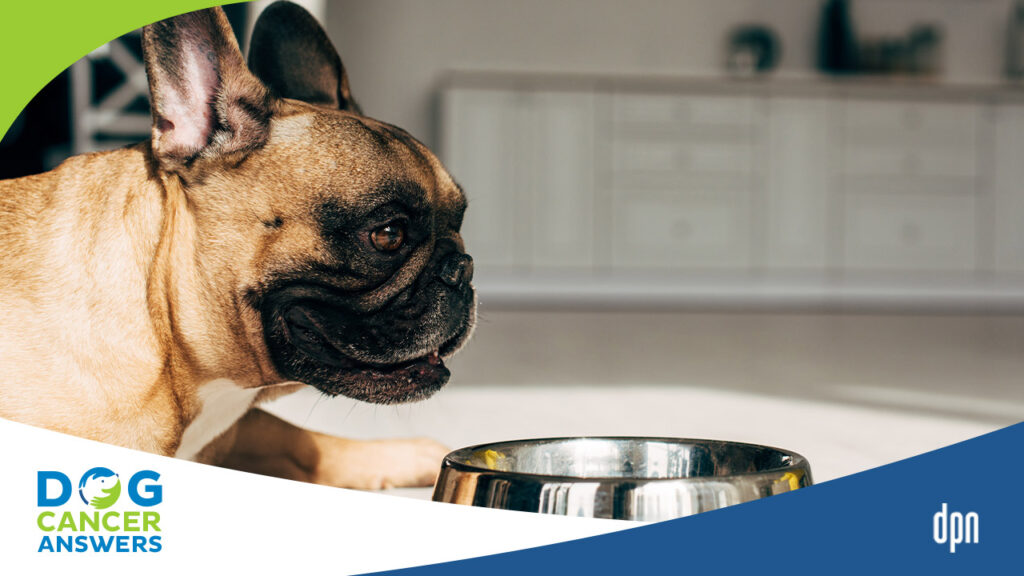Fatty acids are essential in a dog’s diet, particularly omega-6 and omega-3 fatty acids. That means they must come from food because dogs cannot make them in their bodies. Omega-6 and omega-3 fatty acids affect inflammation in the body and can positively affect dogs with cancer.
Key Takeaways
- Omega-6 and omega-3 fatty acids are essential nutrients for dogs and need to be included in the diet to keep your dog healthy.
- Most commercial diets for dogs have enough omega-6 and omega-3 fatty acids to prevent them from developing a deficiency.
- Flaxseed and canola oils are good sources of linoleic acid (LA) and alpha-linolenic acid (ALA) and fish oil is a good source of eiscosapentaenoic acid (EPA) and docosahexaenoic acid (DHA).
- Fish oil is the most commonly used source of omega-3 fatty acids because it has a high amount of eiscosapentaenoic acid (EPA) and docosahexaenoic acid (DHA).
- The best way to make sure your dog gets enough omega-6 and omega-3 fatty acids is by feeding a complete and balanced commercial diet. Fish oil can be used as a supplement for omega-3 fatty acids, but you should consult with your veterinarian to make sure you are not giving too much along with the regular diet.
- Too much fatty acids can cause symptoms like vomiting, diarrhea, poor wound healing, weight gain and blood clotting problems.
- Your dog is likely getting some omega-3 fatty acids every day from their normal diet. You should check with your veterinarian to determine if additional supplementation is needed.
- It can be easy to under or over supplement with fatty acids or give them in an unhealthy ratio. If your veterinarian has recommended supplementing with omega-3 fatty acids, you should use fish oil with a listed amount of eiscosapentaenoic acid (EPA) and docosahexaenoic acid (DHA) to make sure the dosage is correct.
- You should consult your veterinarian before giving a fatty acid supplement to your dog to make sure it will be safe for them, has the correct ingredients and can be given at the correct dosage. Omega-3 fatty acids are usually supplemented through fish oil that contains eiscosapentaenoic acid (EPA) and docosahexaenoic acid (DHA) in measured amounts.
What Omega-3 and Omega-6 Do for Dogs
Omega-6 and omega-3 fatty acids have many different bodily functions, including serving as a fuel source, transporting vitamins, supporting cell membranes, and aiding in cell signaling and regulation.
Because of these important functions, omega fatty acids, especially omega-3s, can be used as supplements in the management of many conditions, including cancer, skin disease, cardiovascular disease, kidney disease, gastrointestinal disease, and orthopedic diseases like arthritis.1–3
Fatty Acids: Lipid Chains
On a chemical level, fatty acids are lipids made up of chains of carbon and hydrogen with varying numbers of double bonds.
Polyunsaturated fatty acids contain two or more double bonds in the chain and are considered “omega” based on the location of the first double bond.
Two of the most well-known omega polyunsaturated fatty acids are the omega-6 and omega-3 fatty acids.
Omega-6 fatty acids include:
- Linoleic acid (LA)
- Arachidonic acid (AA)
Omega-3 fatty acids include:
- Alpha-linolenic acid (ALA)
- Eicosapentaenoic acid (EPA)
- Docosahexaenoic acid (DHA)
Omega-6 and Omega-3 fatty acids are considered essential in the canine diet because they cannot be made and need to be ingested instead.1,2
Sources of Fatty Acids in the Diet
Omega-6 and Omega-3 fatty acids can come from many different souces:1
- Corn oil, peanut oil, and sunflower oil contain linoleic acid (LA) and a small amount of alpha-linolenic acid (ALA)
- Soybean oil, canola oil, and flaxseed oil contain linoleic acid (LA) and alpha-linolenic acid (ALA)
- Animal fat contains arachidonic acid (AA)
- Fish oil, sardines, salmon, mackerel, and fresh tuna contain eicosapentaenoic acid (EPA) and docosahexaenoic acid (DHA)
Dr. Susan Recker discusses omega 3 fatty acids in this compelling episode of DOG CANCER ANSWERS.
Balancing Omega-6 and Omega-3 Fatty Acids
For optimal health, dogs should receive a balanced mixture of both omega-6 and omega-3 fatty acids in their diets.
We don’t know the ideal ratio of omega-6 to omega-3 fatty acids (if there is a single ideal ratio). But we do know a ratio of less than 5:1 can avoid symptoms of excess omega-6 fatty acids.4
A diet higher in omega-6 fatty acids than 5:1 can cause increased inflammation and can reduce the positive impact of omega-3 fatty acids.2
The recommended ratio of omega-6 to omega-3 fatty acids in the diet is a helpful guideline, but the total amount and type of fatty acids in the diet are just as, if not more, important.5
Most commercial diets contain enough omega-6 and omega-3 fatty acids to prevent nutrient deficiencies. However, their ratios can vary (see more about this below).
Effects of Too Much Omega-3 Fatty Acids
Suppose your dog is eating a commercial diet already fortified with essential fatty acids, and you want to start using an omega-3 supplement. In that case, you should discuss the supplement dosage with your veterinarian to avoid the negative effects of excess fatty acids.
Negative side effects of too much omega-3 fatty acids include:5
- delayed wound healing
- vomiting
- diarrhea
- weight gain
- blood clotting problems
- additional changes to immune system function
Effects of Too Little Omega-3 Fatty Acids
Fatty acid deficiencies are seen mostly in dogs eating homemade diets or diets with very low-fat content. For example, homemade diets that use beef tallow, olive oil, or coconut oil are often deficient in fatty acids.
Negative side effects of too little omega-6 and omega-3 fatty acids include:2,6,7
- skin problems like scaling, hair loss, itchiness, bruising
- reproductive problems
- poor growth
- nervous system abnormalities
If you are using a homemade diet for your dog, you should consult a veterinary nutritionist to make sure you are using the correct type and amount of fatty acids.
Fatty Acids and Inflammation
Fatty acids form compounds connected to the responses to infection and injury, which is why they are connected to inflammation.
To simplify things, you can consider omega-6 fatty acids as “pro-inflammatory,” while omega-3 fatty acids are considered “anti-inflammatory.”
Even though “pro-inflammatory” sounds bad, the ability to initiate inflammation is an important function of the immune system. Important healing processes can’t occur without inflammation, and infections may not be managed well. This is why a deficiency in omega-6 fatty acids can result in reproductive problems, skin and coat abnormalities, and a failure to thrive.
However, too much inflammation isn’t good, either. Conditions associated with too much inflammation include arthritis, cancer, and heart disease. Fish oil is high in omega-3 fatty acids, and its anti-inflammatory benefit can be helpful in these conditions.1
Fatty Acids and Cancer
Omega-3 fatty acids have multiple anti-cancer effects.
- If your dog is having trouble eating, supplementing your dog’s diet with omega-3 fatty acids can help improve their appetite and reduce cachexia (wasting).8
- They increase the immune system’s ability to find and kill cancer cells. This can mean reduced cancer development, growth and spread in the body.9
When omega-3 fatty acids (specifically eicosapentaenoic acid (EPA) and docosahexaenoic acid (DHA)) were supplemented with the amino acid arginine, dogs with cancer had improved symptoms, quality of life, and survival time.9
- Omega-3 supplementation improved symptoms, survival time, disease-free interval, and improved quality of life in dogs undergoing chemotherapy for lymphoma.
- Omega-3 supplementation improved the quality of life and reduced the injury to normal tissue in dogs undergoing radiation for nasal tumors.
Omega-3 and Omega-6 in the Diet
Commercial diets for dogs already come with fatty acids to prevent nutritional deficiencies.
However, the amount of omega-3 fatty acids in commercial diets can vary and range from 0.03% to 2.5% by weight on an as-is basis. That is a wide range!
- Foods designed for dogs with arthritis or skin conditions may include more fatty acids than others.10
- Diets for dogs with cancer should contain over 5% of omega-3 fatty acids for optimal health benefits.11
There are minimum dietary fatty acid requirements established per 1,000 kcal of food:1
- Linoleic acid (LA): 2.8 grams
- Alpha-linolenic acid (ALA): 0.11 grams
- Combined eicosapentaenoic acid (EPA) and docosahexaenoic acid (DHA): 0.11 grams
Put another way, an adequate amount of (combined) eicosapentaenoic acid (EPA) and docosahexaenoic acid (DHA) in the diet is 169mg for a 22lb dog.
The exact amount of omega-6 and omega-3 fatty acids may not be listed on your dog’s food, but you can call the manufacturer for more information.
When to Supplement Fatty Acids
In general, you should avoid supplementing your dog’s diet with omega-3 fatty acids by feeding a diet already fortified and balanced. This is an economical choice and will also prevent over-supplementation.
Suppose your dog is eating a commercial diet fortified with higher levels of omega-3 fatty acids. In that case, you should call the manufacturer to ensure you will not exceed the safe upper limit of omega-3 fatty acids if you supplement.
If you are interested in supplementing your dog’s diet, consult your veterinarian to determine the correct amount of omega-3 fatty acids to give your dog.
If your veterinarian thinks your dog would benefit from more omega-3 fatty acids to improve their omega-6 to omega-3 fatty acid ratio, they may recommend a fish oil supplement. Fish oil supplements provide eicosapentaenoic acid (EPA) and docosahexaenoic acid (DHA). A common supplemental dose for dogs is 50-75 mg of eicosapentaenoic acid (EPA) and docosahexaenoic acid (DHA) combined per 2.2 pounds of body weight daily.1
You should be careful not to over supplement dogs with fatty acids. A safe upper limit for combined amounts of eicosapentaenoic acid (EPA) and docosahexaenoic acid (DHA) in the diet is 2,800 mg per 1,000 kcal of diet or 2,080 mg for a 22 pound dog (208 mg per 2.2 lbs).1,5
There are many different fish oil supplements available on the market at any time, and each will show on their label how much total EPA and DHA are in a serving, and sometimes the total omega-3 fatty acid amounts, as well. Be sure to read labels.
Dr. Demian Dressler and Dr. Sue Ettinger (Dr. Sue Cancer Vet) discuss what to feed a dog with cancer -- including omega 3 fatty acids.
Cautions About Omega-3 Supplements
Most dogs can tolerate fish oil supplements well, but you should remember that you are introducing a new, high-fat source into your dog’s diet. This can cause diarrhea in some dogs. Start with a low dose and gradually work up to a full dose over time.
Pancreatitis and Fish Oil Supplements
If your dog has pancreatitis, you might be concerned about giving a fatty acid supplement because high-fat foods can worsen symptoms associated with pancreatitis in some dogs.
There are no reports of omega-3 fatty acid supplements or fish oil causing pancreatitis in dogs, but they should still be used with caution in dogs with a history of pancreatitis due to their high-fat content.5 Be sure to ask your veterinarian about fish oil supplements if your dog has pancreatitis and follow their dosing instructions.
Carprofen and Fish Oil Supplements
You should use caution when supplementing your dog’s diet with omega-3 fatty acids if they take carprofen (Rimadyl®) because it can increase bleeding risk.5
Focus on EPA and DHA
The type of omega-3 fatty acids is very important. Alpha-linolenic (ALA) acid does not have the same benefits as eicosapentaenoic acid (EPA) and docosahexaenoic acid (DHA), so you should read the ingredients of omega-3 supplements carefully.5
Avoid Cod Liver Oil
If your veterinarian has recommended giving your dog a high level of omega-3 fatty acids, you should avoid using cod liver oil. Cod liver oil contains high levels of vitamins A and D which can cause toxicity in high amounts.8
- Lenox CE, Acvn D. ROLE OF DIETARY FATTY ACIDS IN DOGS & CATS. Todays Vet Pract. Published online October 2016. https://navc.com/wp-content/uploads/sites/4/2016/08/TVP_2016-0910_NN-FattyAcids.pdf
- Lenox CE. Timely Topics in Nutrition: An overview of fatty acids in companion animal medicine. J Am Vet Med Assoc. 2015;246(11):1198-1202. doi:10.2460/javma.246.11.1198
- DACVIM (Nutrition) CRH VMD, MS. The Skinny on Fat: Part 2 – Essential fatty acids and inflammation. Clinical Nutrition Service at Cummings School. Published April 2, 2018. Accessed March 27, 2023. https://vetnutrition.tufts.edu/2018/04/essential-fatty-acids-and-inflammation/
- Kearns RJ, Hayek MG, Turek JJ, et al. Effect of age, breed and dietary omega-6 (n-6):omega-3 (n-3) fatty acid ratio on immune function, eicosanoid production, and lipid peroxidation in young and aged dogs. Vet Immunol Immunopathol. 1999;69(2-4):165-183. doi:10.1016/S0165-2427(99)00052-5
- Lenox CE, Bauer JE. Potential Adverse Effects of Omega-3 Fatty Acids in Dogs and Cats. J Vet Intern Med. 2013;27(2):217-226. doi:10.1111/jvim.12033
- Biagi G. The role of dietary omega-3 and omega-6 essential fatty acids in the nutrition of dogs and cats: A review. Prog Nutr. Published online January 2004.
- Stice SA. Omega Fatty Acids. In: Gupta RC, Srivastava A, Lall R, eds. Nutraceuticals in Veterinary Medicine. Springer International Publishing; 2019:175-185. doi:10.1007/978-3-030-04624-8_12
- Freeman LM. Cachexia and Sarcopenia: Emerging Syndromes of Importance in Dogs and Cats. J Vet Intern Med. 2012;26(1):3-17. doi:10.1111/j.1939-1676.2011.00838.x
- Roudebush P, Davenport DJ, Novotny BJ. The use of nutraceuticals in cancer therapy. Vet Clin North Am Small Anim Pract. 2004;34(1):249-269. doi:10.1016/j.cvsm.2003.09.001
- Bauer JE. Therapeutic use of fish oils in companion animals. J Am Vet Med Assoc. 2011;239(11):1441-1451. doi:10.2460/javma.239.11.1441
- Practical Approaches to Feeding the Cancer Patient. Today’s Veterinary Practice. Published July 1, 2014. Accessed May 24, 2023. https://todaysveterinarypractice.com/nutrition/acvn-nutrition-notes-practical-approaches-to-feeding-the-cancer-patient/
- CVPM SW RVT. Fish Oil Dosing in Pet Diets and Supplements. Today’s Veterinary Practice. Published April 17, 2020. Accessed May 24, 2023. https://todaysveterinarypractice.com/nutrition/fish-oil-dosing-in-pet-diets-and-supplements/
Topics
Did You Find This Helpful? Share It with Your Pack!
Use the buttons to share what you learned on social media, download a PDF, print this out, or email it to your veterinarian.









